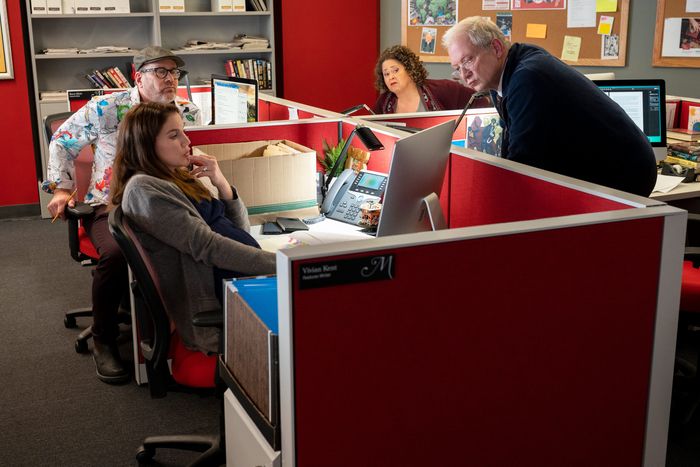
Uh-oh — Vulture has entered our Tudum phase. No sooner had we finished covering And Just Like That …, a show in which we were an unseen supporting player, then along came Inventing Anna, a show set in a fake version of our old office, where the walls are redder, the views better, and the senior editors more villainous (and also straighter).
At the risk of becoming too inside baseball, there is one element of Inventing Anna I must take issue with. As writer Jessica Pressler explained to Vulture, much of what you see on the show has been fictionalized to heighten the drama. But one sneaky element of New York Magazine lore has managed to make the transition from real life to Netflix: the existence of a set of cubicles known as “Scriberia.”
Strangely, though, the term’s meaning seems to have shifted 180 degrees on its way to your TV. In the show, Scriberia is a terrible part of the office. “It’s where you send the old writers to die,” fake Pressler complains to her boss in the first episode. However, one of the first things anyone at the real New York Mag learned was that Scriberia was a good place! In the words of another iconic New York office dweller, “You’re making it sound horrible, and it’s not horrible. It’s nice.”
Yes, I know, the term brings up all sorts of nasty connotations: frozen tundra, forced labor, Stalinist purges. But that’s just the kind of mordant humor you should expect from magazine journalists. The word was coined by longform writer Adam Sternbergh, author of cover stories like “Read This Story and Get Happier” and “Forever Youngish.” Just like in Inventing Anna, Scriberia referred to a remote area of the 75 Varick Street office where the veteran writers sat. It was located what seemed like a half a mile away from the other editorial employees in an inconvenient acute angle no one ever went to or needed to pass through. Its defining qualities were silence and emptiness. And yet there was a charm to it. Writers there had privacy and sunlight, and unlike the rest of us, they had windows that did not look out onto the entrance to the Holland Tunnel. (That is, those of us who were lucky to have windows; the Cut was located in a strange rabbit warren where the cubicle walls were twice as high as anywhere else.)
Sternbergh agrees that there was never any punitive element to the term, except for the joke that the staff writers had been exiled to their own little corner. “Writers: perennially self-deprecating,” he says. But the funny thing about its portrayal in Inventing Anna is that, from the perspective of an entry-level writer, Scriberia was where you wanted to get to! (The only thing more glamorous than being a Scriberian was being one of the writers who never came in to the office. That was real power.) The writers there weren’t sequestered because no one wanted them around anymore; they were kept apart so that they could do actual journalism without the rest of us bothering them. Unlike in the show, where the Scriberians seem to have nothing else going on, the real Scriberia seemed like the (slowly) beating heart of the office. As someone who spent his days writing silly hundred-word blog posts, I had an image of us spinning the hamster wheel that kept the lights on, allowing the older writers to do the work that truly mattered — exposing sexual harassment at Fox News, say, or wondering what was up with avocados.
Of course, now that I’m on the other side of it, my perspective has flipped: It’s clearly the young bloggers who are the voice of the magazine, the ones who give it wit and verve. I guess that’s just part of being a writer — no matter where you sit, you feel like you’re the one out in the cold.


